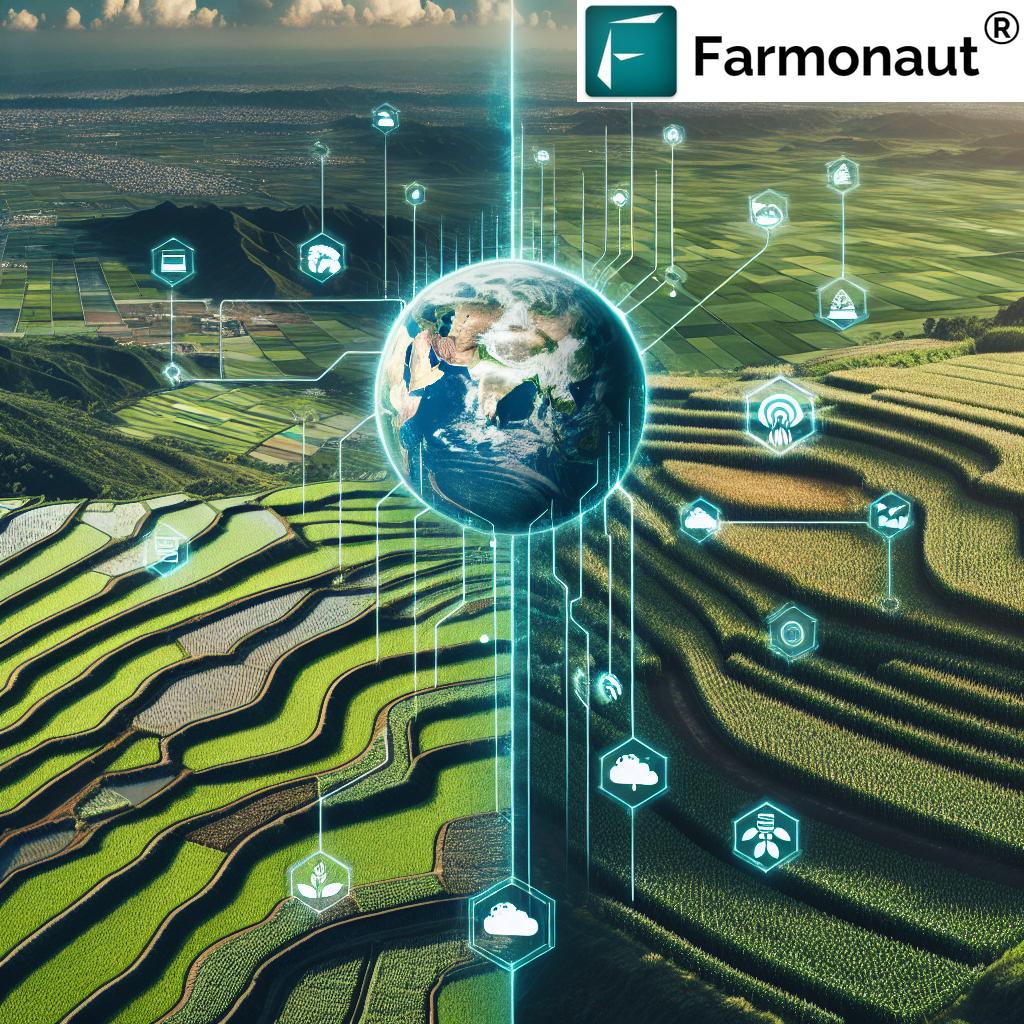Agriculture Climate News July 2025: India Updates & 2024
Table of Contents
- Introduction: Agriculture Climate News July 2025 – India at a Turning Point
- Quick Trivia: July 2025 Climate-Adaptive Shifts
- Climate Impact on Indian Agriculture in July 2025
- Climate Impact & Response Summary Table
- Government Strategies & Policy Responses in 2025
- Technological Advancements & Farming Innovations
- Agricultural Markets & Farmer Welfare
- Outlook: Sustainable Agriculture Beyond 2025
- Farmonaut’s Role in Satellite-Powered Agricultural Solutions
- Try Farmonaut Apps, APIs, and Solutions!
- Mid-Article Trivia: 2025’s Wave of Sustainable Farming
- Frequently Asked Questions (FAQ)
- Farmonaut Subscription Plans
Introduction: Agriculture Climate News July 2025 – India at a Turning Point
The agriculture sector in India has always been the heart of the nation, feeding billions, generating livelihoods, and shaping rural economies. However, as climate change accelerates, this sector finds itself at the forefront of vulnerability—and innovation. The latest agriculture climate news July 2025 underscores how rapidly shifting weather conditions, erratic monsoon patterns, and frequent extreme events are compelling both farmers and policymakers to rethink strategies and embrace sustainability.
This comprehensive update spotlights the key developments shaping agriculture news India July 2025, including:
- New government interventions and policies addressing climate risks,
- Technological progress in precision and regenerative farming,
- Market and livelihood impacts for millions of rural Indians,
- And a look forward at the strategies needed for a secure, sustainable future.
Read on for expert analysis, high-impact figures, actionable resources, videos, and a region-wise breakdown.
“In July 2025, India reported a 15% increase in climate-resilient crop adoption compared to July 2024.”
Climate Impact on Indian Agriculture in July 2025
The agriculture climate news July 2025 reveals that India is grappling with multifaceted challenges rooted in shifting weather patterns and climatic conditions. The period from June to July 2025 brought a confluence of erratic monsoon distributions, a 15% rainfall deviation from historical averages (as per the India Meteorological Department – IMD), and a spike in the frequency of extreme events like scorched heatwaves and unseasonal rains.
Key Weather Events Affecting Farming
- Delayed, unpredictable monsoons: Major states like Maharashtra, Karnataka, and parts of Tamil Nadu reported sowing delays for staple crops such as pulses, millets, and oilseeds.
- Drought Intensification: Rainfed areas in southern and western India faced significant water stress, soil moisture deficits, and reduced crop yields.
- Unseasonal Rains & Heatwaves: Large swathes experienced crop-damaging unseasonal showers, while others saw record high temperatures affecting the growth cycle and productivity of key crops.
Direct Impacts on Production & Livelihoods
- 15% rainfall deviation in major zones (IMD report) resulted in lower area under sowing and prompted urgent revisions in cropping patterns.
- States including Maharashtra, Karnataka, and parts of Tamil Nadu saw up to 18–22% reductions in area sown under millets and oilseeds.
- This triggered market responses—inflation in essential cereals and pulses, threatening food security for millions.
- Rural livelihoods across India remain at risk as farmer income is hit by climatic unpredictability and supply-demand imbalances.
As agriculture news India July 2025 continues to develop, adaptation and resilience are the central themes for every farmer, policymaker, and industry stakeholder in the country.
Climate Impact & Response Summary Table – Agriculture Climate News July 2025
For a concise yet comprehensive view, here’s a region-wise table summarizing July 2025’s key events, crop impacts, and sustainable responses:
| Region/State | Estimated Weather Event | Main Affected Crop(s) | Estimated Impact | Government Intervention | Sustainable Farming Innovation/Practice |
|---|---|---|---|---|---|
| Maharashtra | Delayed monsoon, drought | Millets, Soybean, Oilseeds | Yield -20%; 1.2M ha affected | Increased MSP, drip irrigation subsidy | Soil moisture monitoring, shift to short-duration crop varieties |
| Karnataka | Unseasonal rains, heatwave | Pulses, Paddy | Yield -18%; 0.9M ha affected | Weather-indexed crop insurance, advisory expansion | Adoption of drought-tolerant seeds, conservation tillage |
| Tamil Nadu (Southern districts) | Reduced rainfall, higher temperatures | Groundnut, Rice | Yield -22%; 0.6M ha affected | Irrigation scheme roll-out, market intervention | Regenerative agriculture, crop diversification |
| Punjab & Haryana | Late monsoon onset | Wheat, Rice | Yield -10%; 1.1M ha affected | MSP reinforcement, buffer stock build-up | AI-driven sowing advisories, organic amendments |
| Eastern UP & Bihar | Erratic monsoon, local flooding | Paddy, Maize | Yield -14%; 0.8M ha affected | Relief packages, extension services | Improved water management, alternate wet/dry irrigation |
Government Strategies & Policy Responses in 2025
National- and state-level intervention is central to the agriculture climate news July 2025. The evolving policy landscape is driven by the urgent need to secure food security, rural livelihoods, and build long-term resilience in an era of climate change.
NAPCRA Roll-out and Targeted Strategies
- National Action Plan on Climate Resilient Agriculture (NAPCRA): Accelerated implementation in July 2025 focusing on climate-smart seed varieties, soil health, and water management.
- Subsidy Schemes: Expansion of government support for drip irrigation, drought-tolerant seeds, and weather-indexed insurance.
- Digital Advisory Services: Agro-meteorological weather and crop advisories pushed to farmers in local languages via SMS, apps, and call centres—empowering farmers to adapt practices in real-time.
- Extension of MSP and Market Buffering: To counter market volatility, buffer stocks for essential crops have been increased and Minimum Support Price procurement reinforced.
Key Initiatives at a Glance
- Weather-indexed insurance: New schemes launched in Jharkhand and Odisha, covering over 2.5 million hectares of key crops.
- Support for Farmer Producer Organisations (FPOs): Enhanced credit lines and market access measures for smallholders to boost resilience and fair pricing.
- Capacity-building: National-level workshops on adaptive farm management, resource-efficient cropping, and digital literacy for farmers.
The government is also expanding satellite-based crop loan and insurance solutions (learn about verification & risk reduction—especially in drought-affected states). These satellite-powered services help streamline damage assessment, reduce fraud, and ensure faster financial support delivery in the wake of adverse climatic events.
Technological Advancements & Sustainable Farming Innovations
The agriculture climate news July 2025 highlights a distinct surge in technology adoption. Modern agricultural technologies—AI-driven advisory, satellite monitoring, and blockchain—are rapidly transforming how farmers manage crops, soil, and resources.
Precision Farming, Satellite Data, and AI
- Satellite-based monitoring: Farmers are leveraging satellite imagery systems to assess vegetation health, detect early signs of water stress, and plan irrigation with precision, even in remote rural areas.
- AI-Powered Advisory Tools: Real-time alerts about weather, pest outbreaks, and crop growth stages allow tactical, timely interventions.
- Blockchain Traceability: Producers and markets are beginning to use blockchain—offering transparency and consumer assurance in supply chains. See how Farmonaut Product Traceability strengthens supply authenticity across agriculture and allied sectors.
Regenerative Agriculture & Soil Health: The Next Wave
- Conservation Tillage: Increased use of minimal tilling methods to retain soil moisture.
- Crop Diversification: Farmers are shifting towards diverse, climate-resilient cropping systems for enhanced food security and risk mitigation.
- Organic Amendments: Incorporation of compost, biochar, and natural fortifiers to improve soil health and carbon sequestration.
- Water-efficient Practices: Precision drip irrigation and alternate wet/dry rice schemes are crucial tools for sustainable water management.
Watch the future of precision and regenerative farming unfold in:
Farmers employing satellite-driven soil moisture monitoring have seen reductions in irrigation usage and improved yield stability—even under adverse weather.
Carbon Footprinting – The New Compliance Frontier
- With new national and global requirements, producers can now measure and reduce their carbon footprint using real-time tracking tools and analytics. This supports climate goals and improves long-term productivity and resource efficiency.
Agricultural Markets & Farmer Welfare in the Face of Climate Uncertainty
The impact of climate on agriculture affects not only production but also the market and welfare systems upon which farmers rely. From July 2025’s vantage point:
Volatile Crop Prices & Market Responses
- Production volatility: Disruptions in sowing and output—exacerbated by climate change—have made price swings more pronounced this season, especially in essential cereals and pulses.
- Buffer Stocks and MSP: The government’s push to strengthen buffer stocks and the Minimum Support Price (MSP) regime is crucial in stabilizing rural incomes.
- Digital Extension Services: Organisations and farmer producer groups are harnessing digital channels to connect growers with credit, technology, and advisory support.
At the same time, focus remains on inclusive access to farm management platforms—these help agricultural businesses and collectives efficiently monitor crops, manage risk, and centralize advisory for large areas, making adaptation scalable across India.
Outlook: Sustainable Agriculture Beyond July 2025
Despite marked improvements, India’s agriculture sector faces persistent challenges on the road to sustainability:
- Small, fragmented land holdings limit economies of scale for many climate-adaptive solutions.
- Supply chain inefficiencies amplify market volatility.
- Infrastructure investment in irrigation, storage, and technology extension is urgently needed—especially for marginalized rural communities.
However, policy support, scientific innovation, and community engagement are converging to create a framework for robust, climate-resilient agriculture in India. In the context of rising agriculture climate news July 2025, these trends:
- Support a more reliable food supply for a growing population.
- Secure rural livelihoods amid greater environmental volatility.
- Move the sector towards sustainability, resource efficiency, and long-term resilience.
Farmonaut’s Role in Satellite-Powered Agricultural Solutions
As the demand for adaptive, affordable, and high-impact agriculture technologies grows in 2025, we at Farmonaut deliver a comprehensive suite of satellite, AI, and blockchain-powered tools that respond to these very challenges:
- Satellite-based Monitoring: We make it easy for individual farmers, co-operatives, and agribusinesses to remotely assess crop health, soil moisture, and even environmental impact at scale, using smartphone or web apps—no expensive hardware needed.
- Jeevn AI Advisory: Our real-time, context-aware AI delivers custom weather alerts, resource allocation tips, and pest/disease advisories—crucial for climate-resilient management.
- Blockchain Traceability: With our blockchain product traceability solution, supply chains from the field to final market can now be verified, increasing transparency and trust among buyers and consumers.
- Fleet & Resource Management: Our suite also helps manage agri fleets, reducing operational costs and enhancing safety, especially on large farms. Explore our fleet management system for agriculture.
- Environmental Impact Tracking: Track carbon emissions, water use, and overall environmental footprint—making compliance and sustainability measurable. Learn about carbon footprinting with Farmonaut for your agri-business.
All these solutions are accessible via Android, iOS, web apps, and Farmonaut API (for developers and agritech integrators).
Interested in API integration? Read our developer documentation.
Our goal is to empower all players in Indian agriculture–from smallholder farmers to large producers and government agencies–to thrive despite climate uncertainty, improving productivity, resource efficiency, and rural welfare.
Try Farmonaut Apps, APIs, and Solutions!
“Over 60% of Indian states introduced new sustainable farming policies in response to shifting weather patterns in 2025.”
Frequently Asked Questions (FAQ) – Agriculture Climate News India July 2025
Q1. What are the main highlights from agriculture climate news July 2025 for India?
The July 2025 update is dominated by continued erratic monsoon patterns, increased drought intensity across key states, newly launched government schemes for climate adaptation (including expanded weather-indexed insurance and drip irrigation subsidies), surging technology adoption in satellite monitoring and AI advisories, and a marked increase in climate-resilient crop adoption.
Q2. Which Indian regions were most impacted by climate change in July 2025?
Maharashtra, Karnataka, and parts of Tamil Nadu saw severe drought and heat, affecting millet, oilseed, and pulse production. Northern states like Punjab and Haryana faced late monsoons impacting wheat and rice productivity, while Eastern UP and Bihar endured erratic rainfall and local flooding.
Q3. What are climate-resilient crops, and why are farmers in India adopting them?
Climate-resilient crops are varieties bred to withstand drought, high heat, and fluctuating weather patterns. In July 2025, their adoption increased by 15% over the previous year, empowering farmers to maintain income and yields in unstable climatic conditions.
Q4. How is technology helping Indian agriculture adapt in 2025?
Technologies like satellite imagery, AI, and blockchain provide real-time monitoring of crops, predictive advisory for weather and pests, reliable insurance risk assessment, and improved transparency/buyer trust through traceability. This reduces input waste, supports precision farming, and enables faster, data-driven decisions in the face of climate shocks.
Q5. Where can I access main Farmonaut products for agriculture?
You can try our web app, apps for Android and iOS, API developer tools, and see our portfolio of solutions for carbon footprint tracking, product traceability, fleet management, and satellite-based crop insurance.
Q6. How can I stay updated on agriculture climate news India July 2025 and beyond?
Bookmark this blog or subscribe to news from reputed agencies. For real-time agritech updates and weather intelligence tailored to your region, use advisory platforms like Farmonaut.
Farmonaut Subscription Plans
Whether you are an individual farmer, a business, or a government agency looking to implement satellite-based agricultural solutions or APIs for your projects, explore our secure and affordable subscription tiers below.
Conclusion: India’s Agriculture Faces the Future with Climate Resilience
The agriculture climate news July 2025 stands as a call to action for India. Adaptation is no longer optional. Through government interventions, technological innovation, and growing farmer empowerment, the sector is showing resilience in the face of climate-driven uncertainty.
Our collective challenge is to build upon this momentum—expanding access, improving infrastructure, and deepening the integration of data-driven and sustainable practices. As the sector evolves, India will continue to be a global focal point in the journey towards climate-resilient, food-secure, and sustainable agriculture.
Stay informed, stay climate-resilient. For more news on agriculture, climate updates, and agri-technology, bookmark this blog and follow our updates through 2025 and beyond.













